Analyzing Blockchain Technology's Impact on Healthcare Systems
VerifiedAdded on 2022/08/22
|11
|3324
|44
Report
AI Summary
This report provides an in-depth analysis of blockchain technology within the healthcare sector, focusing on its potential to revolutionize data management, security, and patient care. It explores the core concepts of blockchain, including its structure, features, and the utilization of smart contracts. The report examines the socio-technical issues associated with blockchain implementation, such as the need for user engagement and the shift from information to value in clinical contexts. It highlights the challenges of integrating blockchain into existing healthcare systems, emphasizing the importance of addressing interoperability and security concerns to achieve improved patient outcomes. The report also discusses the potential for blockchain to address issues of data privacy and improve the efficiency of healthcare operations. Ultimately, the report argues for a comprehensive approach that considers both the technological and societal implications of blockchain in healthcare.
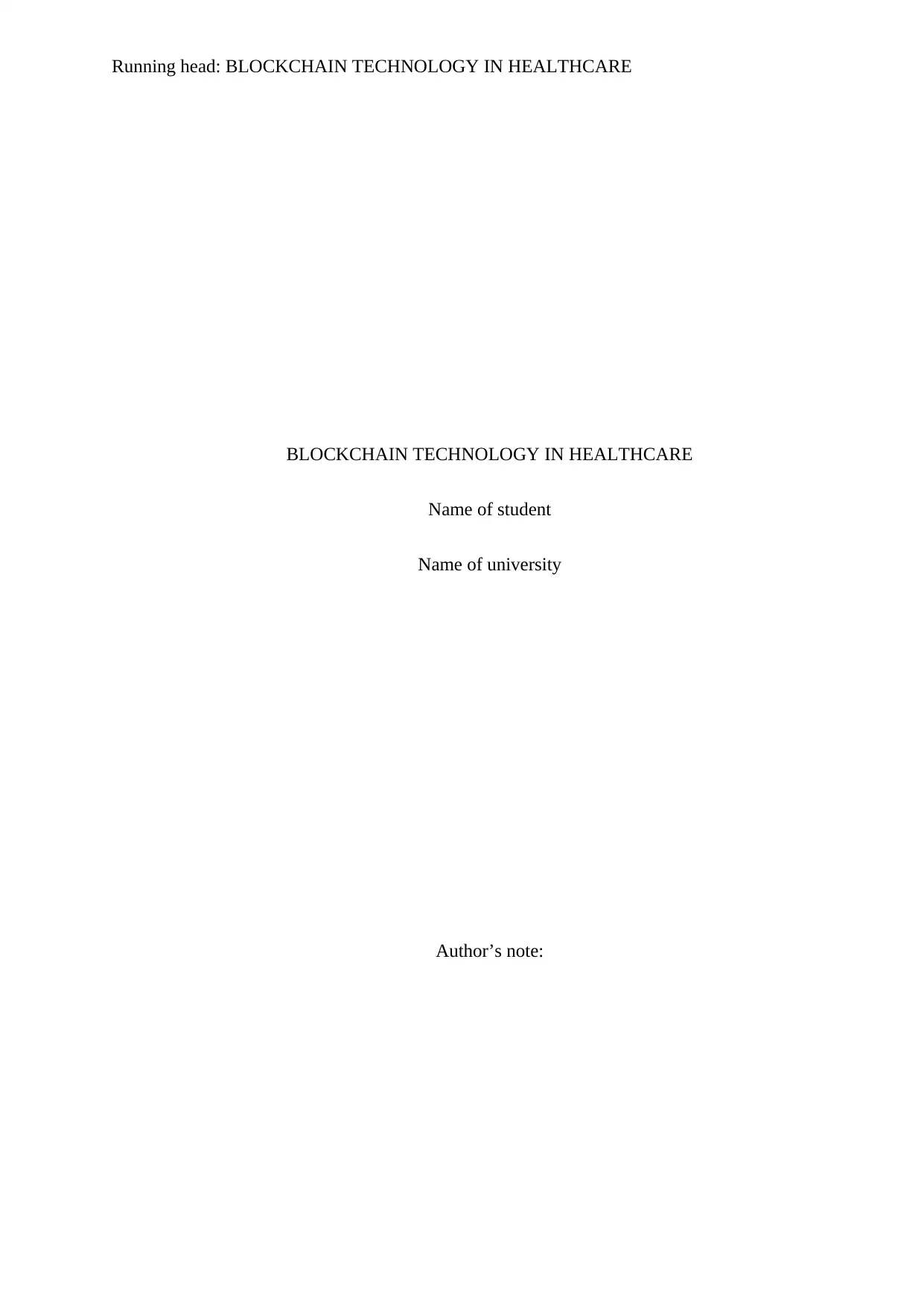
Running head: BLOCKCHAIN TECHNOLOGY IN HEALTHCARE
BLOCKCHAIN TECHNOLOGY IN HEALTHCARE
Name of student
Name of university
Author’s note:
BLOCKCHAIN TECHNOLOGY IN HEALTHCARE
Name of student
Name of university
Author’s note:
Paraphrase This Document
Need a fresh take? Get an instant paraphrase of this document with our AI Paraphraser
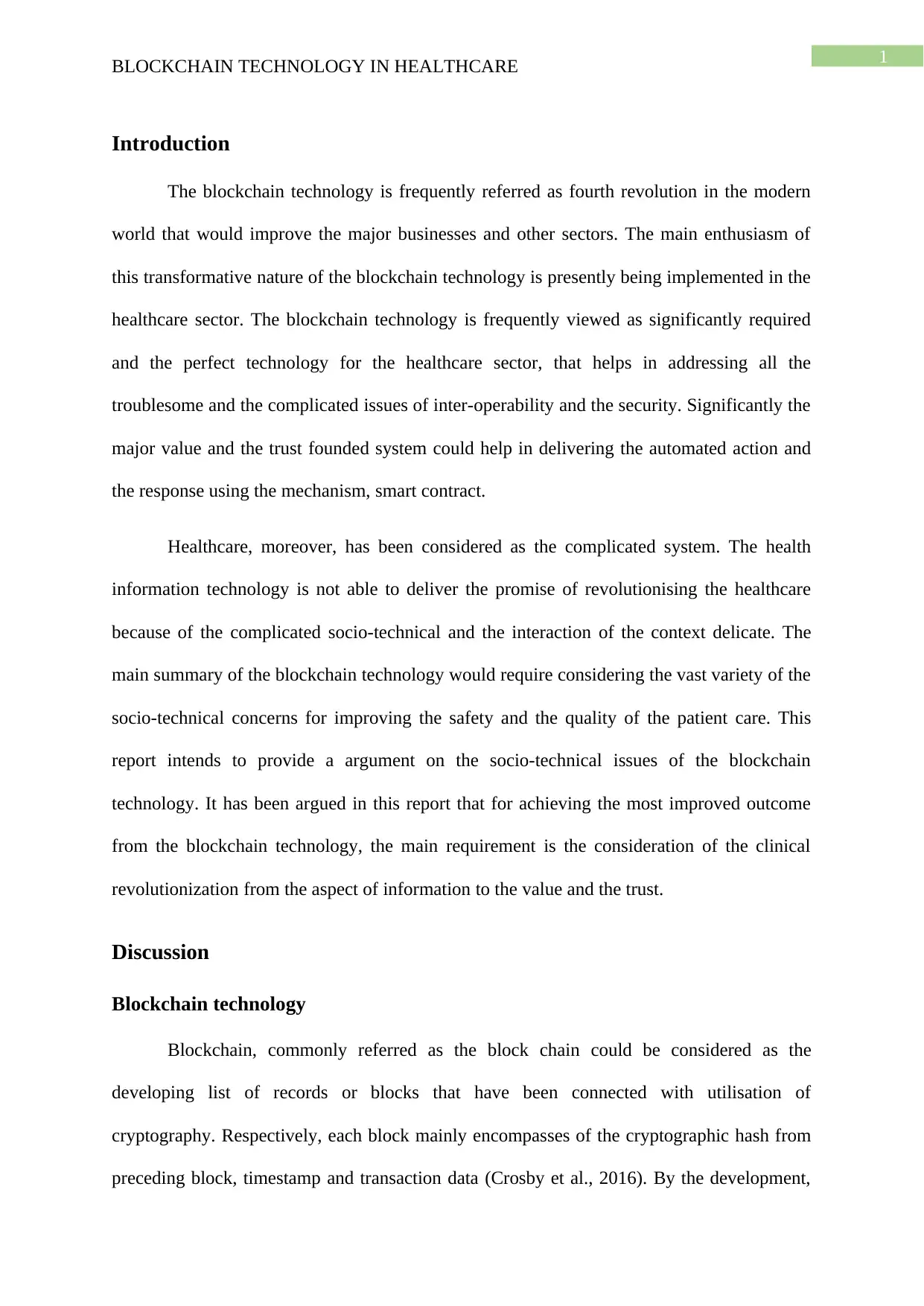
1
BLOCKCHAIN TECHNOLOGY IN HEALTHCARE
Introduction
The blockchain technology is frequently referred as fourth revolution in the modern
world that would improve the major businesses and other sectors. The main enthusiasm of
this transformative nature of the blockchain technology is presently being implemented in the
healthcare sector. The blockchain technology is frequently viewed as significantly required
and the perfect technology for the healthcare sector, that helps in addressing all the
troublesome and the complicated issues of inter-operability and the security. Significantly the
major value and the trust founded system could help in delivering the automated action and
the response using the mechanism, smart contract.
Healthcare, moreover, has been considered as the complicated system. The health
information technology is not able to deliver the promise of revolutionising the healthcare
because of the complicated socio-technical and the interaction of the context delicate. The
main summary of the blockchain technology would require considering the vast variety of the
socio-technical concerns for improving the safety and the quality of the patient care. This
report intends to provide a argument on the socio-technical issues of the blockchain
technology. It has been argued in this report that for achieving the most improved outcome
from the blockchain technology, the main requirement is the consideration of the clinical
revolutionization from the aspect of information to the value and the trust.
Discussion
Blockchain technology
Blockchain, commonly referred as the block chain could be considered as the
developing list of records or blocks that have been connected with utilisation of
cryptography. Respectively, each block mainly encompasses of the cryptographic hash from
preceding block, timestamp and transaction data (Crosby et al., 2016). By the development,
BLOCKCHAIN TECHNOLOGY IN HEALTHCARE
Introduction
The blockchain technology is frequently referred as fourth revolution in the modern
world that would improve the major businesses and other sectors. The main enthusiasm of
this transformative nature of the blockchain technology is presently being implemented in the
healthcare sector. The blockchain technology is frequently viewed as significantly required
and the perfect technology for the healthcare sector, that helps in addressing all the
troublesome and the complicated issues of inter-operability and the security. Significantly the
major value and the trust founded system could help in delivering the automated action and
the response using the mechanism, smart contract.
Healthcare, moreover, has been considered as the complicated system. The health
information technology is not able to deliver the promise of revolutionising the healthcare
because of the complicated socio-technical and the interaction of the context delicate. The
main summary of the blockchain technology would require considering the vast variety of the
socio-technical concerns for improving the safety and the quality of the patient care. This
report intends to provide a argument on the socio-technical issues of the blockchain
technology. It has been argued in this report that for achieving the most improved outcome
from the blockchain technology, the main requirement is the consideration of the clinical
revolutionization from the aspect of information to the value and the trust.
Discussion
Blockchain technology
Blockchain, commonly referred as the block chain could be considered as the
developing list of records or blocks that have been connected with utilisation of
cryptography. Respectively, each block mainly encompasses of the cryptographic hash from
preceding block, timestamp and transaction data (Crosby et al., 2016). By the development,
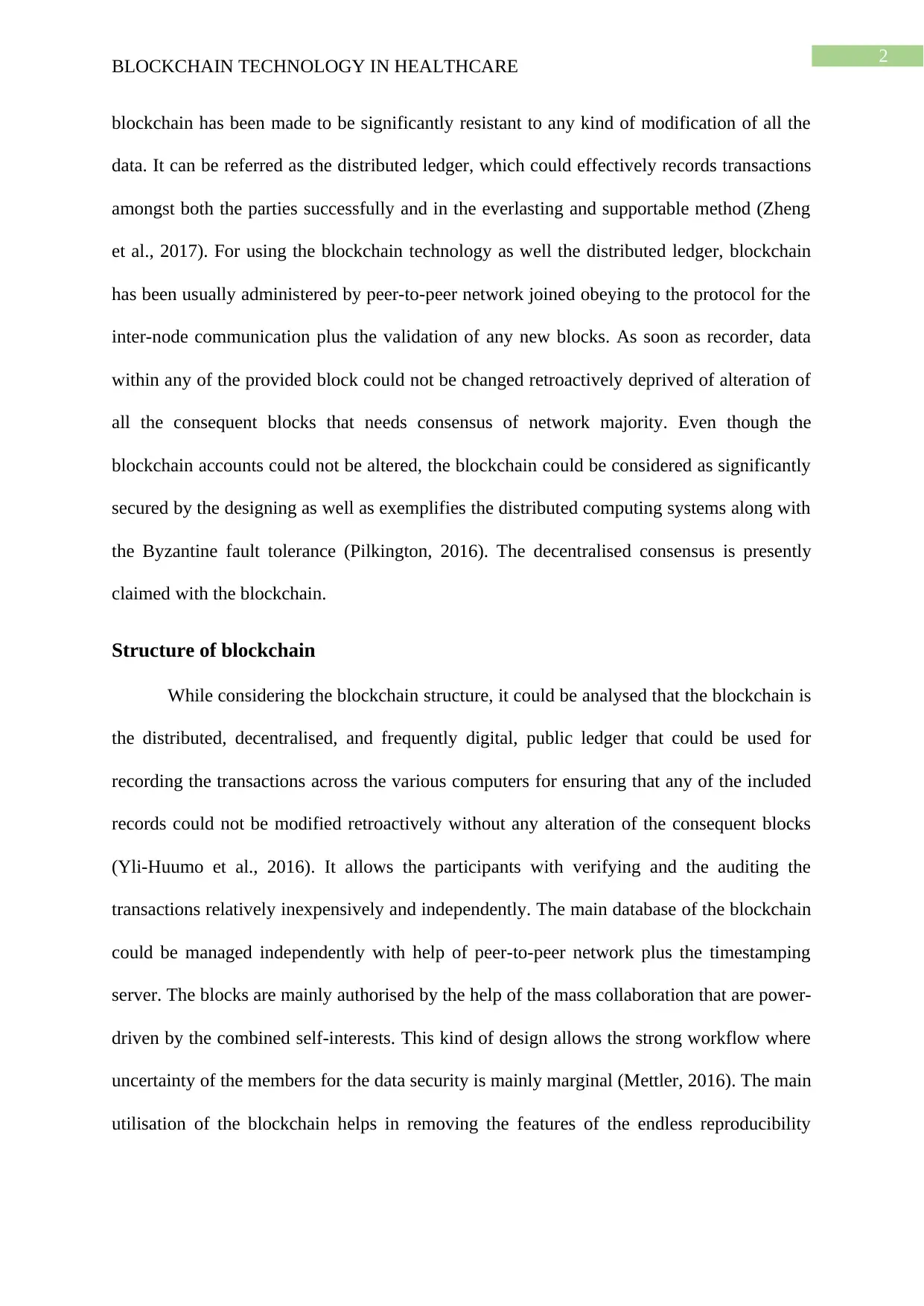
2
BLOCKCHAIN TECHNOLOGY IN HEALTHCARE
blockchain has been made to be significantly resistant to any kind of modification of all the
data. It can be referred as the distributed ledger, which could effectively records transactions
amongst both the parties successfully and in the everlasting and supportable method (Zheng
et al., 2017). For using the blockchain technology as well the distributed ledger, blockchain
has been usually administered by peer-to-peer network joined obeying to the protocol for the
inter-node communication plus the validation of any new blocks. As soon as recorder, data
within any of the provided block could not be changed retroactively deprived of alteration of
all the consequent blocks that needs consensus of network majority. Even though the
blockchain accounts could not be altered, the blockchain could be considered as significantly
secured by the designing as well as exemplifies the distributed computing systems along with
the Byzantine fault tolerance (Pilkington, 2016). The decentralised consensus is presently
claimed with the blockchain.
Structure of blockchain
While considering the blockchain structure, it could be analysed that the blockchain is
the distributed, decentralised, and frequently digital, public ledger that could be used for
recording the transactions across the various computers for ensuring that any of the included
records could not be modified retroactively without any alteration of the consequent blocks
(Yli-Huumo et al., 2016). It allows the participants with verifying and the auditing the
transactions relatively inexpensively and independently. The main database of the blockchain
could be managed independently with help of peer-to-peer network plus the timestamping
server. The blocks are mainly authorised by the help of the mass collaboration that are power-
driven by the combined self-interests. This kind of design allows the strong workflow where
uncertainty of the members for the data security is mainly marginal (Mettler, 2016). The main
utilisation of the blockchain helps in removing the features of the endless reproducibility
BLOCKCHAIN TECHNOLOGY IN HEALTHCARE
blockchain has been made to be significantly resistant to any kind of modification of all the
data. It can be referred as the distributed ledger, which could effectively records transactions
amongst both the parties successfully and in the everlasting and supportable method (Zheng
et al., 2017). For using the blockchain technology as well the distributed ledger, blockchain
has been usually administered by peer-to-peer network joined obeying to the protocol for the
inter-node communication plus the validation of any new blocks. As soon as recorder, data
within any of the provided block could not be changed retroactively deprived of alteration of
all the consequent blocks that needs consensus of network majority. Even though the
blockchain accounts could not be altered, the blockchain could be considered as significantly
secured by the designing as well as exemplifies the distributed computing systems along with
the Byzantine fault tolerance (Pilkington, 2016). The decentralised consensus is presently
claimed with the blockchain.
Structure of blockchain
While considering the blockchain structure, it could be analysed that the blockchain is
the distributed, decentralised, and frequently digital, public ledger that could be used for
recording the transactions across the various computers for ensuring that any of the included
records could not be modified retroactively without any alteration of the consequent blocks
(Yli-Huumo et al., 2016). It allows the participants with verifying and the auditing the
transactions relatively inexpensively and independently. The main database of the blockchain
could be managed independently with help of peer-to-peer network plus the timestamping
server. The blocks are mainly authorised by the help of the mass collaboration that are power-
driven by the combined self-interests. This kind of design allows the strong workflow where
uncertainty of the members for the data security is mainly marginal (Mettler, 2016). The main
utilisation of the blockchain helps in removing the features of the endless reproducibility
⊘ This is a preview!⊘
Do you want full access?
Subscribe today to unlock all pages.

Trusted by 1+ million students worldwide
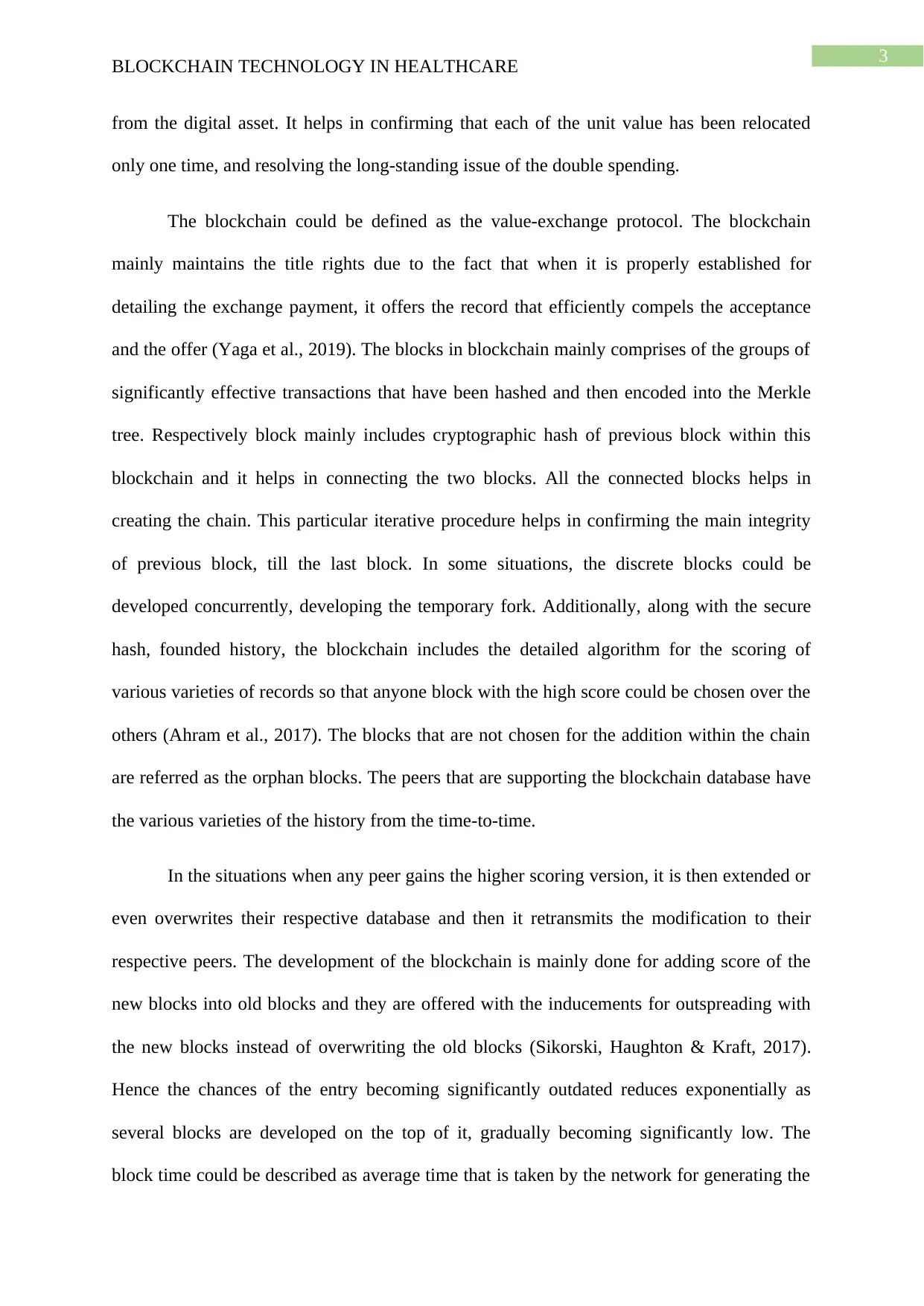
3
BLOCKCHAIN TECHNOLOGY IN HEALTHCARE
from the digital asset. It helps in confirming that each of the unit value has been relocated
only one time, and resolving the long-standing issue of the double spending.
The blockchain could be defined as the value-exchange protocol. The blockchain
mainly maintains the title rights due to the fact that when it is properly established for
detailing the exchange payment, it offers the record that efficiently compels the acceptance
and the offer (Yaga et al., 2019). The blocks in blockchain mainly comprises of the groups of
significantly effective transactions that have been hashed and then encoded into the Merkle
tree. Respectively block mainly includes cryptographic hash of previous block within this
blockchain and it helps in connecting the two blocks. All the connected blocks helps in
creating the chain. This particular iterative procedure helps in confirming the main integrity
of previous block, till the last block. In some situations, the discrete blocks could be
developed concurrently, developing the temporary fork. Additionally, along with the secure
hash, founded history, the blockchain includes the detailed algorithm for the scoring of
various varieties of records so that anyone block with the high score could be chosen over the
others (Ahram et al., 2017). The blocks that are not chosen for the addition within the chain
are referred as the orphan blocks. The peers that are supporting the blockchain database have
the various varieties of the history from the time-to-time.
In the situations when any peer gains the higher scoring version, it is then extended or
even overwrites their respective database and then it retransmits the modification to their
respective peers. The development of the blockchain is mainly done for adding score of the
new blocks into old blocks and they are offered with the inducements for outspreading with
the new blocks instead of overwriting the old blocks (Sikorski, Haughton & Kraft, 2017).
Hence the chances of the entry becoming significantly outdated reduces exponentially as
several blocks are developed on the top of it, gradually becoming significantly low. The
block time could be described as average time that is taken by the network for generating the
BLOCKCHAIN TECHNOLOGY IN HEALTHCARE
from the digital asset. It helps in confirming that each of the unit value has been relocated
only one time, and resolving the long-standing issue of the double spending.
The blockchain could be defined as the value-exchange protocol. The blockchain
mainly maintains the title rights due to the fact that when it is properly established for
detailing the exchange payment, it offers the record that efficiently compels the acceptance
and the offer (Yaga et al., 2019). The blocks in blockchain mainly comprises of the groups of
significantly effective transactions that have been hashed and then encoded into the Merkle
tree. Respectively block mainly includes cryptographic hash of previous block within this
blockchain and it helps in connecting the two blocks. All the connected blocks helps in
creating the chain. This particular iterative procedure helps in confirming the main integrity
of previous block, till the last block. In some situations, the discrete blocks could be
developed concurrently, developing the temporary fork. Additionally, along with the secure
hash, founded history, the blockchain includes the detailed algorithm for the scoring of
various varieties of records so that anyone block with the high score could be chosen over the
others (Ahram et al., 2017). The blocks that are not chosen for the addition within the chain
are referred as the orphan blocks. The peers that are supporting the blockchain database have
the various varieties of the history from the time-to-time.
In the situations when any peer gains the higher scoring version, it is then extended or
even overwrites their respective database and then it retransmits the modification to their
respective peers. The development of the blockchain is mainly done for adding score of the
new blocks into old blocks and they are offered with the inducements for outspreading with
the new blocks instead of overwriting the old blocks (Sikorski, Haughton & Kraft, 2017).
Hence the chances of the entry becoming significantly outdated reduces exponentially as
several blocks are developed on the top of it, gradually becoming significantly low. The
block time could be described as average time that is taken by the network for generating the
Paraphrase This Document
Need a fresh take? Get an instant paraphrase of this document with our AI Paraphraser
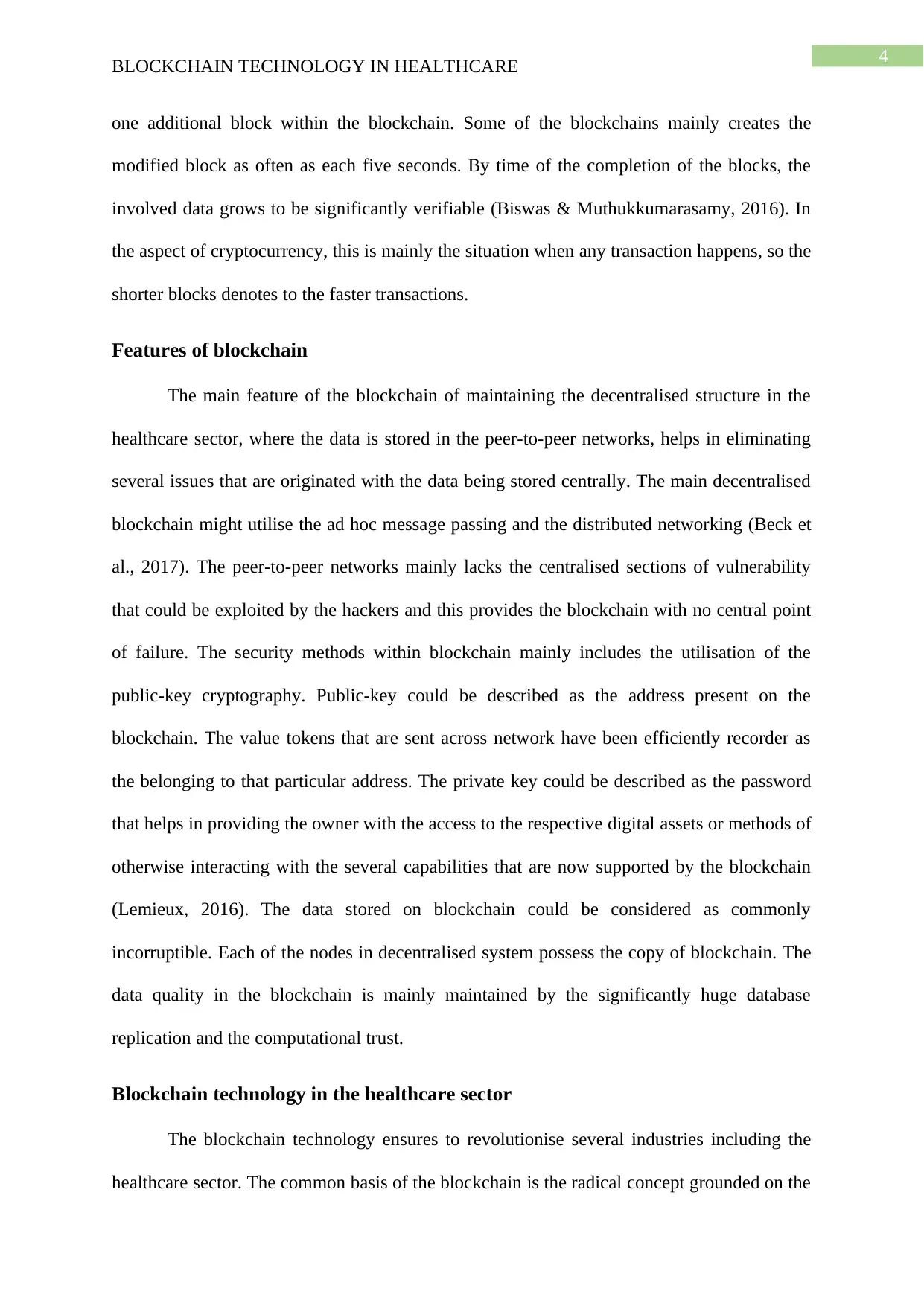
4
BLOCKCHAIN TECHNOLOGY IN HEALTHCARE
one additional block within the blockchain. Some of the blockchains mainly creates the
modified block as often as each five seconds. By time of the completion of the blocks, the
involved data grows to be significantly verifiable (Biswas & Muthukkumarasamy, 2016). In
the aspect of cryptocurrency, this is mainly the situation when any transaction happens, so the
shorter blocks denotes to the faster transactions.
Features of blockchain
The main feature of the blockchain of maintaining the decentralised structure in the
healthcare sector, where the data is stored in the peer-to-peer networks, helps in eliminating
several issues that are originated with the data being stored centrally. The main decentralised
blockchain might utilise the ad hoc message passing and the distributed networking (Beck et
al., 2017). The peer-to-peer networks mainly lacks the centralised sections of vulnerability
that could be exploited by the hackers and this provides the blockchain with no central point
of failure. The security methods within blockchain mainly includes the utilisation of the
public-key cryptography. Public-key could be described as the address present on the
blockchain. The value tokens that are sent across network have been efficiently recorder as
the belonging to that particular address. The private key could be described as the password
that helps in providing the owner with the access to the respective digital assets or methods of
otherwise interacting with the several capabilities that are now supported by the blockchain
(Lemieux, 2016). The data stored on blockchain could be considered as commonly
incorruptible. Each of the nodes in decentralised system possess the copy of blockchain. The
data quality in the blockchain is mainly maintained by the significantly huge database
replication and the computational trust.
Blockchain technology in the healthcare sector
The blockchain technology ensures to revolutionise several industries including the
healthcare sector. The common basis of the blockchain is the radical concept grounded on the
BLOCKCHAIN TECHNOLOGY IN HEALTHCARE
one additional block within the blockchain. Some of the blockchains mainly creates the
modified block as often as each five seconds. By time of the completion of the blocks, the
involved data grows to be significantly verifiable (Biswas & Muthukkumarasamy, 2016). In
the aspect of cryptocurrency, this is mainly the situation when any transaction happens, so the
shorter blocks denotes to the faster transactions.
Features of blockchain
The main feature of the blockchain of maintaining the decentralised structure in the
healthcare sector, where the data is stored in the peer-to-peer networks, helps in eliminating
several issues that are originated with the data being stored centrally. The main decentralised
blockchain might utilise the ad hoc message passing and the distributed networking (Beck et
al., 2017). The peer-to-peer networks mainly lacks the centralised sections of vulnerability
that could be exploited by the hackers and this provides the blockchain with no central point
of failure. The security methods within blockchain mainly includes the utilisation of the
public-key cryptography. Public-key could be described as the address present on the
blockchain. The value tokens that are sent across network have been efficiently recorder as
the belonging to that particular address. The private key could be described as the password
that helps in providing the owner with the access to the respective digital assets or methods of
otherwise interacting with the several capabilities that are now supported by the blockchain
(Lemieux, 2016). The data stored on blockchain could be considered as commonly
incorruptible. Each of the nodes in decentralised system possess the copy of blockchain. The
data quality in the blockchain is mainly maintained by the significantly huge database
replication and the computational trust.
Blockchain technology in the healthcare sector
The blockchain technology ensures to revolutionise several industries including the
healthcare sector. The common basis of the blockchain is the radical concept grounded on the
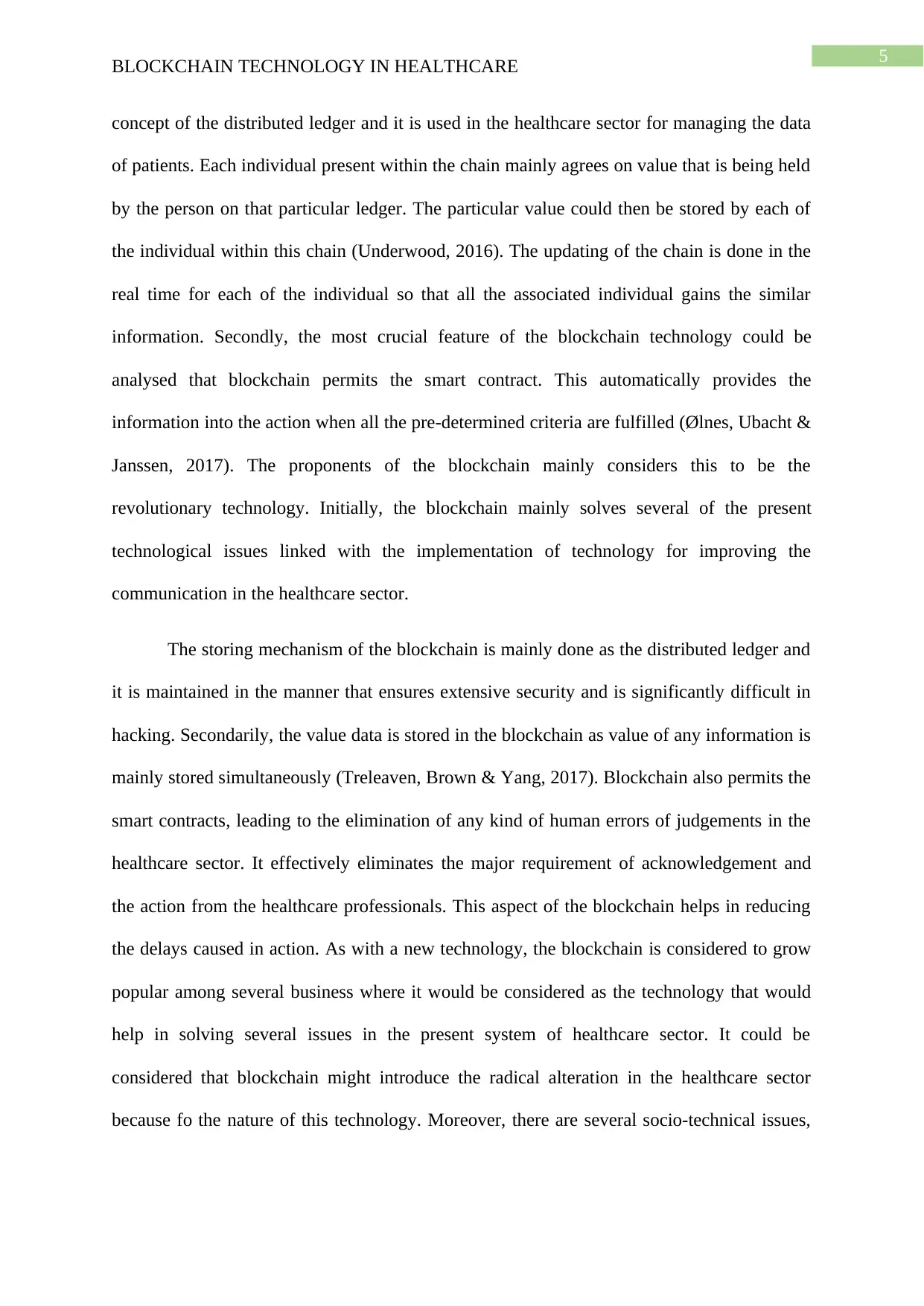
5
BLOCKCHAIN TECHNOLOGY IN HEALTHCARE
concept of the distributed ledger and it is used in the healthcare sector for managing the data
of patients. Each individual present within the chain mainly agrees on value that is being held
by the person on that particular ledger. The particular value could then be stored by each of
the individual within this chain (Underwood, 2016). The updating of the chain is done in the
real time for each of the individual so that all the associated individual gains the similar
information. Secondly, the most crucial feature of the blockchain technology could be
analysed that blockchain permits the smart contract. This automatically provides the
information into the action when all the pre-determined criteria are fulfilled (Ølnes, Ubacht &
Janssen, 2017). The proponents of the blockchain mainly considers this to be the
revolutionary technology. Initially, the blockchain mainly solves several of the present
technological issues linked with the implementation of technology for improving the
communication in the healthcare sector.
The storing mechanism of the blockchain is mainly done as the distributed ledger and
it is maintained in the manner that ensures extensive security and is significantly difficult in
hacking. Secondarily, the value data is stored in the blockchain as value of any information is
mainly stored simultaneously (Treleaven, Brown & Yang, 2017). Blockchain also permits the
smart contracts, leading to the elimination of any kind of human errors of judgements in the
healthcare sector. It effectively eliminates the major requirement of acknowledgement and
the action from the healthcare professionals. This aspect of the blockchain helps in reducing
the delays caused in action. As with a new technology, the blockchain is considered to grow
popular among several business where it would be considered as the technology that would
help in solving several issues in the present system of healthcare sector. It could be
considered that blockchain might introduce the radical alteration in the healthcare sector
because fo the nature of this technology. Moreover, there are several socio-technical issues,
BLOCKCHAIN TECHNOLOGY IN HEALTHCARE
concept of the distributed ledger and it is used in the healthcare sector for managing the data
of patients. Each individual present within the chain mainly agrees on value that is being held
by the person on that particular ledger. The particular value could then be stored by each of
the individual within this chain (Underwood, 2016). The updating of the chain is done in the
real time for each of the individual so that all the associated individual gains the similar
information. Secondly, the most crucial feature of the blockchain technology could be
analysed that blockchain permits the smart contract. This automatically provides the
information into the action when all the pre-determined criteria are fulfilled (Ølnes, Ubacht &
Janssen, 2017). The proponents of the blockchain mainly considers this to be the
revolutionary technology. Initially, the blockchain mainly solves several of the present
technological issues linked with the implementation of technology for improving the
communication in the healthcare sector.
The storing mechanism of the blockchain is mainly done as the distributed ledger and
it is maintained in the manner that ensures extensive security and is significantly difficult in
hacking. Secondarily, the value data is stored in the blockchain as value of any information is
mainly stored simultaneously (Treleaven, Brown & Yang, 2017). Blockchain also permits the
smart contracts, leading to the elimination of any kind of human errors of judgements in the
healthcare sector. It effectively eliminates the major requirement of acknowledgement and
the action from the healthcare professionals. This aspect of the blockchain helps in reducing
the delays caused in action. As with a new technology, the blockchain is considered to grow
popular among several business where it would be considered as the technology that would
help in solving several issues in the present system of healthcare sector. It could be
considered that blockchain might introduce the radical alteration in the healthcare sector
because fo the nature of this technology. Moreover, there are several socio-technical issues,
⊘ This is a preview!⊘
Do you want full access?
Subscribe today to unlock all pages.

Trusted by 1+ million students worldwide
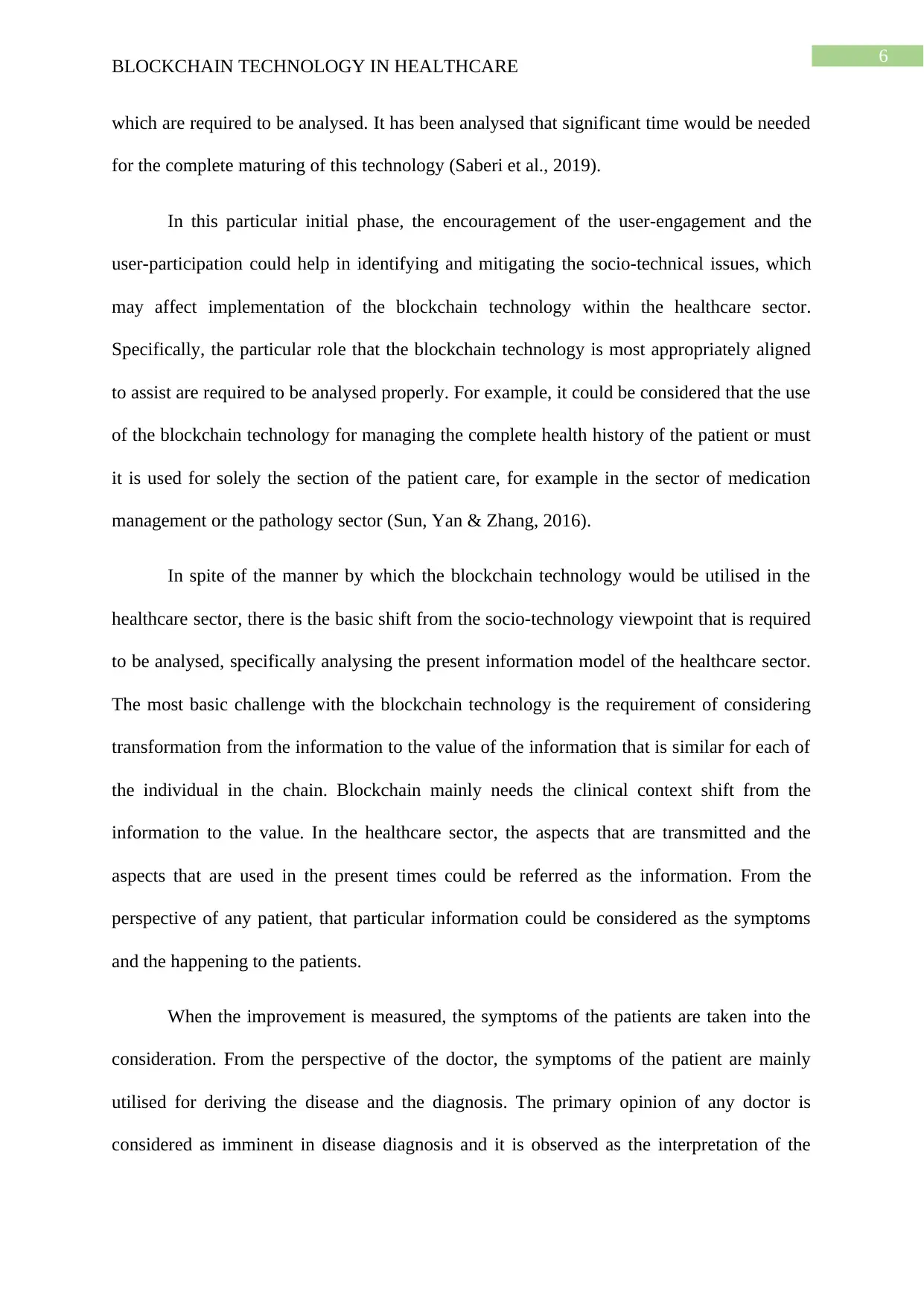
6
BLOCKCHAIN TECHNOLOGY IN HEALTHCARE
which are required to be analysed. It has been analysed that significant time would be needed
for the complete maturing of this technology (Saberi et al., 2019).
In this particular initial phase, the encouragement of the user-engagement and the
user-participation could help in identifying and mitigating the socio-technical issues, which
may affect implementation of the blockchain technology within the healthcare sector.
Specifically, the particular role that the blockchain technology is most appropriately aligned
to assist are required to be analysed properly. For example, it could be considered that the use
of the blockchain technology for managing the complete health history of the patient or must
it is used for solely the section of the patient care, for example in the sector of medication
management or the pathology sector (Sun, Yan & Zhang, 2016).
In spite of the manner by which the blockchain technology would be utilised in the
healthcare sector, there is the basic shift from the socio-technology viewpoint that is required
to be analysed, specifically analysing the present information model of the healthcare sector.
The most basic challenge with the blockchain technology is the requirement of considering
transformation from the information to the value of the information that is similar for each of
the individual in the chain. Blockchain mainly needs the clinical context shift from the
information to the value. In the healthcare sector, the aspects that are transmitted and the
aspects that are used in the present times could be referred as the information. From the
perspective of any patient, that particular information could be considered as the symptoms
and the happening to the patients.
When the improvement is measured, the symptoms of the patients are taken into the
consideration. From the perspective of the doctor, the symptoms of the patient are mainly
utilised for deriving the disease and the diagnosis. The primary opinion of any doctor is
considered as imminent in disease diagnosis and it is observed as the interpretation of the
BLOCKCHAIN TECHNOLOGY IN HEALTHCARE
which are required to be analysed. It has been analysed that significant time would be needed
for the complete maturing of this technology (Saberi et al., 2019).
In this particular initial phase, the encouragement of the user-engagement and the
user-participation could help in identifying and mitigating the socio-technical issues, which
may affect implementation of the blockchain technology within the healthcare sector.
Specifically, the particular role that the blockchain technology is most appropriately aligned
to assist are required to be analysed properly. For example, it could be considered that the use
of the blockchain technology for managing the complete health history of the patient or must
it is used for solely the section of the patient care, for example in the sector of medication
management or the pathology sector (Sun, Yan & Zhang, 2016).
In spite of the manner by which the blockchain technology would be utilised in the
healthcare sector, there is the basic shift from the socio-technology viewpoint that is required
to be analysed, specifically analysing the present information model of the healthcare sector.
The most basic challenge with the blockchain technology is the requirement of considering
transformation from the information to the value of the information that is similar for each of
the individual in the chain. Blockchain mainly needs the clinical context shift from the
information to the value. In the healthcare sector, the aspects that are transmitted and the
aspects that are used in the present times could be referred as the information. From the
perspective of any patient, that particular information could be considered as the symptoms
and the happening to the patients.
When the improvement is measured, the symptoms of the patients are taken into the
consideration. From the perspective of the doctor, the symptoms of the patient are mainly
utilised for deriving the disease and the diagnosis. The primary opinion of any doctor is
considered as imminent in disease diagnosis and it is observed as the interpretation of the
Paraphrase This Document
Need a fresh take? Get an instant paraphrase of this document with our AI Paraphraser
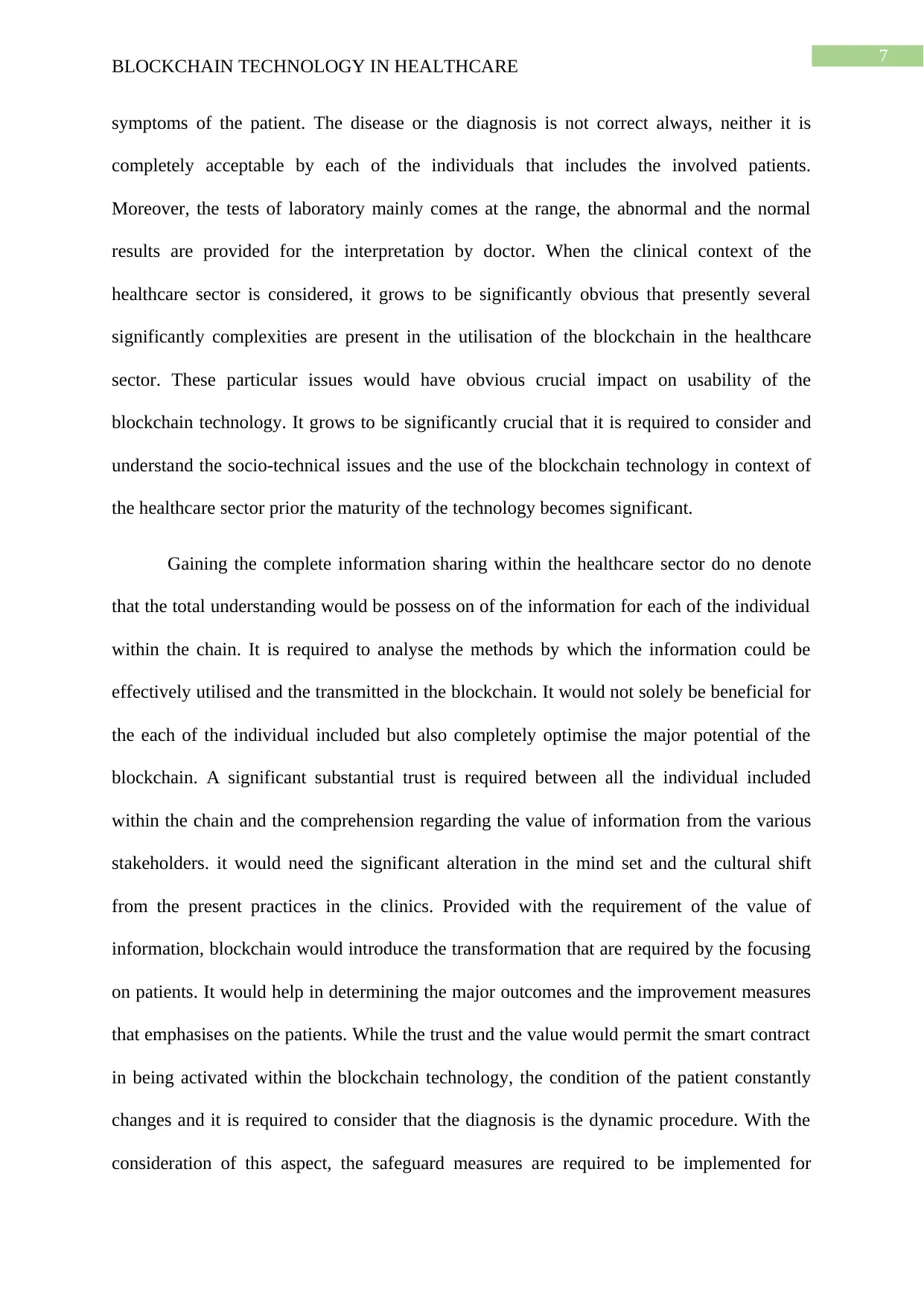
7
BLOCKCHAIN TECHNOLOGY IN HEALTHCARE
symptoms of the patient. The disease or the diagnosis is not correct always, neither it is
completely acceptable by each of the individuals that includes the involved patients.
Moreover, the tests of laboratory mainly comes at the range, the abnormal and the normal
results are provided for the interpretation by doctor. When the clinical context of the
healthcare sector is considered, it grows to be significantly obvious that presently several
significantly complexities are present in the utilisation of the blockchain in the healthcare
sector. These particular issues would have obvious crucial impact on usability of the
blockchain technology. It grows to be significantly crucial that it is required to consider and
understand the socio-technical issues and the use of the blockchain technology in context of
the healthcare sector prior the maturity of the technology becomes significant.
Gaining the complete information sharing within the healthcare sector do no denote
that the total understanding would be possess on of the information for each of the individual
within the chain. It is required to analyse the methods by which the information could be
effectively utilised and the transmitted in the blockchain. It would not solely be beneficial for
the each of the individual included but also completely optimise the major potential of the
blockchain. A significant substantial trust is required between all the individual included
within the chain and the comprehension regarding the value of information from the various
stakeholders. it would need the significant alteration in the mind set and the cultural shift
from the present practices in the clinics. Provided with the requirement of the value of
information, blockchain would introduce the transformation that are required by the focusing
on patients. It would help in determining the major outcomes and the improvement measures
that emphasises on the patients. While the trust and the value would permit the smart contract
in being activated within the blockchain technology, the condition of the patient constantly
changes and it is required to consider that the diagnosis is the dynamic procedure. With the
consideration of this aspect, the safeguard measures are required to be implemented for
BLOCKCHAIN TECHNOLOGY IN HEALTHCARE
symptoms of the patient. The disease or the diagnosis is not correct always, neither it is
completely acceptable by each of the individuals that includes the involved patients.
Moreover, the tests of laboratory mainly comes at the range, the abnormal and the normal
results are provided for the interpretation by doctor. When the clinical context of the
healthcare sector is considered, it grows to be significantly obvious that presently several
significantly complexities are present in the utilisation of the blockchain in the healthcare
sector. These particular issues would have obvious crucial impact on usability of the
blockchain technology. It grows to be significantly crucial that it is required to consider and
understand the socio-technical issues and the use of the blockchain technology in context of
the healthcare sector prior the maturity of the technology becomes significant.
Gaining the complete information sharing within the healthcare sector do no denote
that the total understanding would be possess on of the information for each of the individual
within the chain. It is required to analyse the methods by which the information could be
effectively utilised and the transmitted in the blockchain. It would not solely be beneficial for
the each of the individual included but also completely optimise the major potential of the
blockchain. A significant substantial trust is required between all the individual included
within the chain and the comprehension regarding the value of information from the various
stakeholders. it would need the significant alteration in the mind set and the cultural shift
from the present practices in the clinics. Provided with the requirement of the value of
information, blockchain would introduce the transformation that are required by the focusing
on patients. It would help in determining the major outcomes and the improvement measures
that emphasises on the patients. While the trust and the value would permit the smart contract
in being activated within the blockchain technology, the condition of the patient constantly
changes and it is required to consider that the diagnosis is the dynamic procedure. With the
consideration of this aspect, the safeguard measures are required to be implemented for
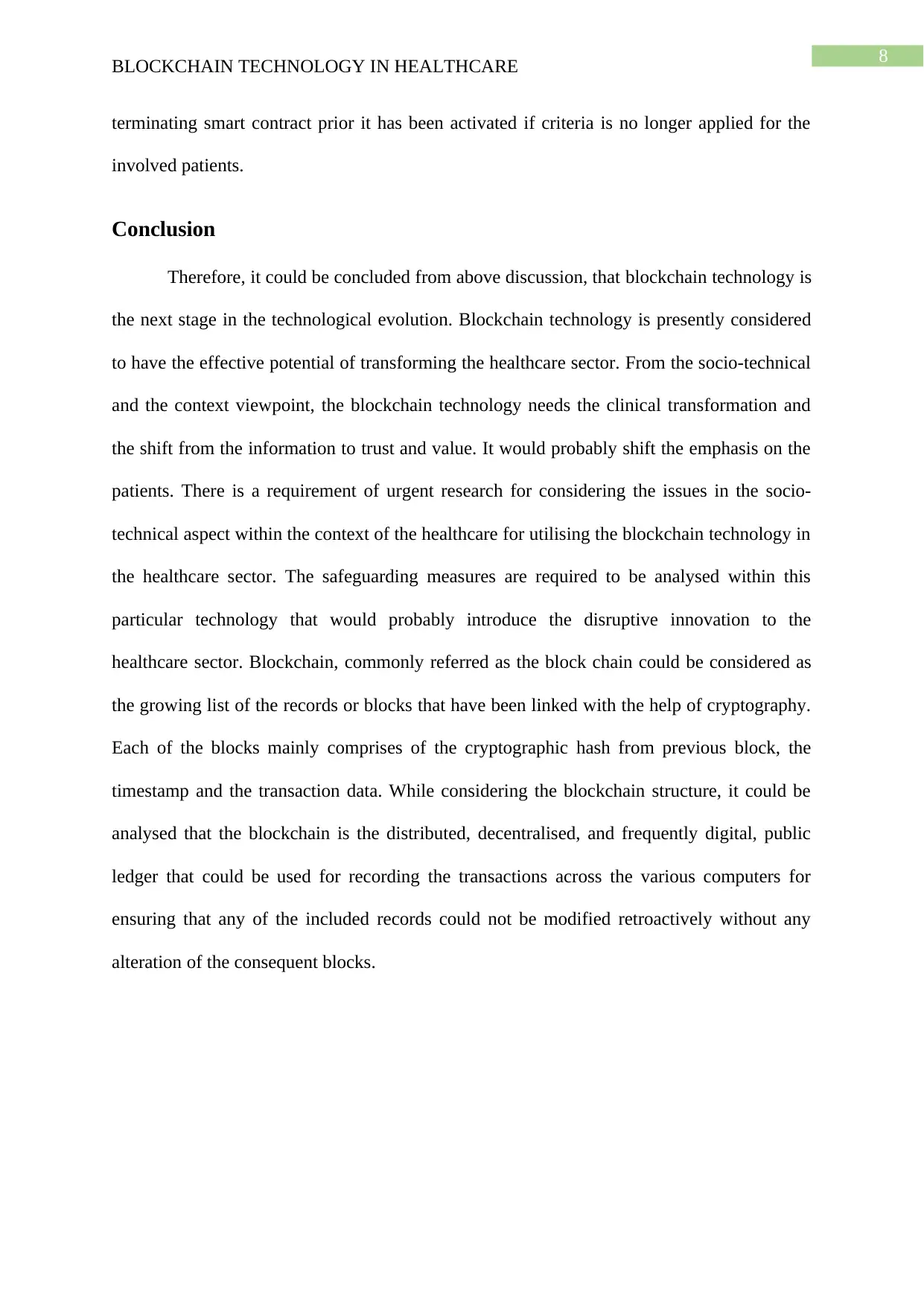
8
BLOCKCHAIN TECHNOLOGY IN HEALTHCARE
terminating smart contract prior it has been activated if criteria is no longer applied for the
involved patients.
Conclusion
Therefore, it could be concluded from above discussion, that blockchain technology is
the next stage in the technological evolution. Blockchain technology is presently considered
to have the effective potential of transforming the healthcare sector. From the socio-technical
and the context viewpoint, the blockchain technology needs the clinical transformation and
the shift from the information to trust and value. It would probably shift the emphasis on the
patients. There is a requirement of urgent research for considering the issues in the socio-
technical aspect within the context of the healthcare for utilising the blockchain technology in
the healthcare sector. The safeguarding measures are required to be analysed within this
particular technology that would probably introduce the disruptive innovation to the
healthcare sector. Blockchain, commonly referred as the block chain could be considered as
the growing list of the records or blocks that have been linked with the help of cryptography.
Each of the blocks mainly comprises of the cryptographic hash from previous block, the
timestamp and the transaction data. While considering the blockchain structure, it could be
analysed that the blockchain is the distributed, decentralised, and frequently digital, public
ledger that could be used for recording the transactions across the various computers for
ensuring that any of the included records could not be modified retroactively without any
alteration of the consequent blocks.
BLOCKCHAIN TECHNOLOGY IN HEALTHCARE
terminating smart contract prior it has been activated if criteria is no longer applied for the
involved patients.
Conclusion
Therefore, it could be concluded from above discussion, that blockchain technology is
the next stage in the technological evolution. Blockchain technology is presently considered
to have the effective potential of transforming the healthcare sector. From the socio-technical
and the context viewpoint, the blockchain technology needs the clinical transformation and
the shift from the information to trust and value. It would probably shift the emphasis on the
patients. There is a requirement of urgent research for considering the issues in the socio-
technical aspect within the context of the healthcare for utilising the blockchain technology in
the healthcare sector. The safeguarding measures are required to be analysed within this
particular technology that would probably introduce the disruptive innovation to the
healthcare sector. Blockchain, commonly referred as the block chain could be considered as
the growing list of the records or blocks that have been linked with the help of cryptography.
Each of the blocks mainly comprises of the cryptographic hash from previous block, the
timestamp and the transaction data. While considering the blockchain structure, it could be
analysed that the blockchain is the distributed, decentralised, and frequently digital, public
ledger that could be used for recording the transactions across the various computers for
ensuring that any of the included records could not be modified retroactively without any
alteration of the consequent blocks.
⊘ This is a preview!⊘
Do you want full access?
Subscribe today to unlock all pages.

Trusted by 1+ million students worldwide
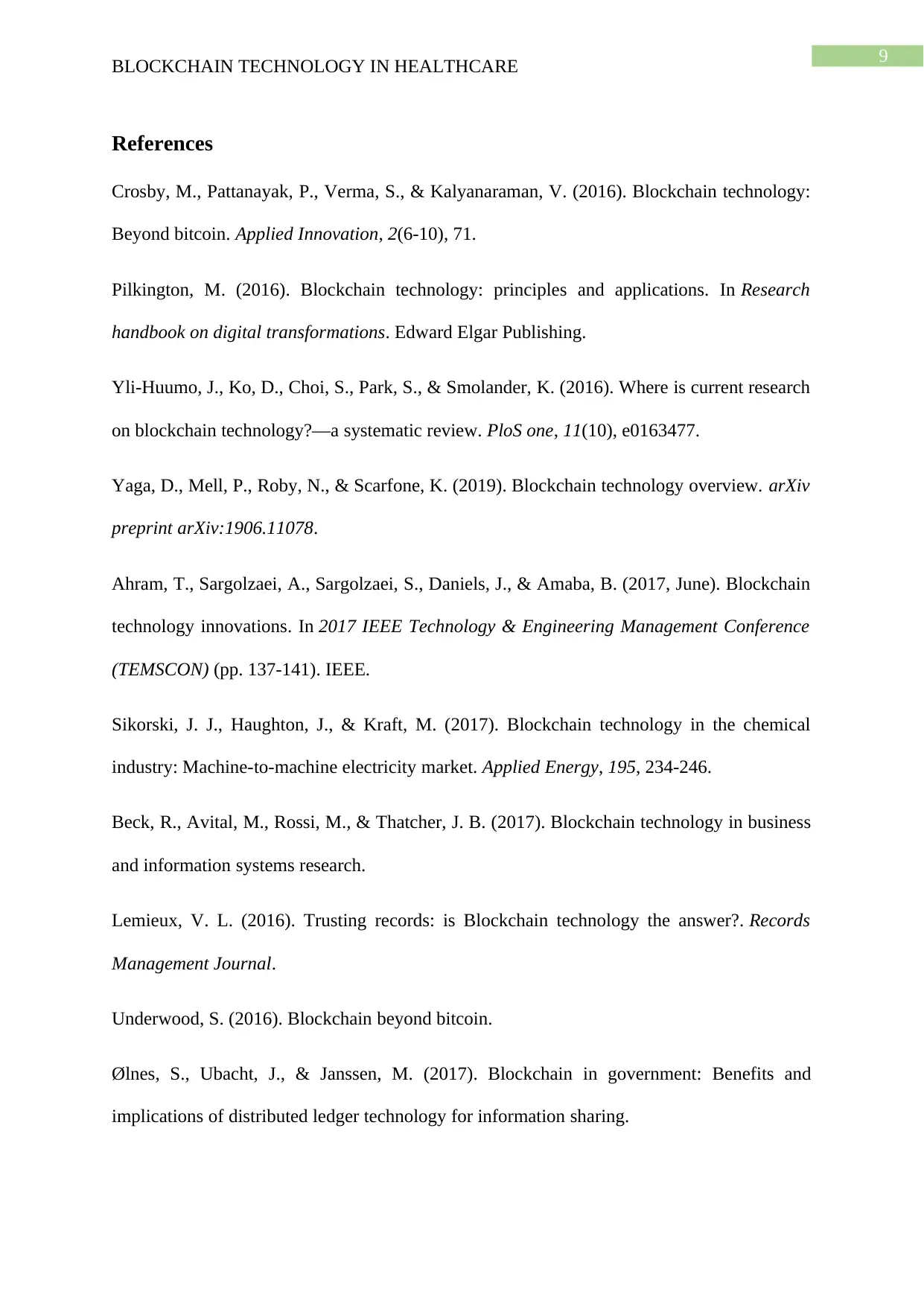
9
BLOCKCHAIN TECHNOLOGY IN HEALTHCARE
References
Crosby, M., Pattanayak, P., Verma, S., & Kalyanaraman, V. (2016). Blockchain technology:
Beyond bitcoin. Applied Innovation, 2(6-10), 71.
Pilkington, M. (2016). Blockchain technology: principles and applications. In Research
handbook on digital transformations. Edward Elgar Publishing.
Yli-Huumo, J., Ko, D., Choi, S., Park, S., & Smolander, K. (2016). Where is current research
on blockchain technology?—a systematic review. PloS one, 11(10), e0163477.
Yaga, D., Mell, P., Roby, N., & Scarfone, K. (2019). Blockchain technology overview. arXiv
preprint arXiv:1906.11078.
Ahram, T., Sargolzaei, A., Sargolzaei, S., Daniels, J., & Amaba, B. (2017, June). Blockchain
technology innovations. In 2017 IEEE Technology & Engineering Management Conference
(TEMSCON) (pp. 137-141). IEEE.
Sikorski, J. J., Haughton, J., & Kraft, M. (2017). Blockchain technology in the chemical
industry: Machine-to-machine electricity market. Applied Energy, 195, 234-246.
Beck, R., Avital, M., Rossi, M., & Thatcher, J. B. (2017). Blockchain technology in business
and information systems research.
Lemieux, V. L. (2016). Trusting records: is Blockchain technology the answer?. Records
Management Journal.
Underwood, S. (2016). Blockchain beyond bitcoin.
Ølnes, S., Ubacht, J., & Janssen, M. (2017). Blockchain in government: Benefits and
implications of distributed ledger technology for information sharing.
BLOCKCHAIN TECHNOLOGY IN HEALTHCARE
References
Crosby, M., Pattanayak, P., Verma, S., & Kalyanaraman, V. (2016). Blockchain technology:
Beyond bitcoin. Applied Innovation, 2(6-10), 71.
Pilkington, M. (2016). Blockchain technology: principles and applications. In Research
handbook on digital transformations. Edward Elgar Publishing.
Yli-Huumo, J., Ko, D., Choi, S., Park, S., & Smolander, K. (2016). Where is current research
on blockchain technology?—a systematic review. PloS one, 11(10), e0163477.
Yaga, D., Mell, P., Roby, N., & Scarfone, K. (2019). Blockchain technology overview. arXiv
preprint arXiv:1906.11078.
Ahram, T., Sargolzaei, A., Sargolzaei, S., Daniels, J., & Amaba, B. (2017, June). Blockchain
technology innovations. In 2017 IEEE Technology & Engineering Management Conference
(TEMSCON) (pp. 137-141). IEEE.
Sikorski, J. J., Haughton, J., & Kraft, M. (2017). Blockchain technology in the chemical
industry: Machine-to-machine electricity market. Applied Energy, 195, 234-246.
Beck, R., Avital, M., Rossi, M., & Thatcher, J. B. (2017). Blockchain technology in business
and information systems research.
Lemieux, V. L. (2016). Trusting records: is Blockchain technology the answer?. Records
Management Journal.
Underwood, S. (2016). Blockchain beyond bitcoin.
Ølnes, S., Ubacht, J., & Janssen, M. (2017). Blockchain in government: Benefits and
implications of distributed ledger technology for information sharing.
Paraphrase This Document
Need a fresh take? Get an instant paraphrase of this document with our AI Paraphraser
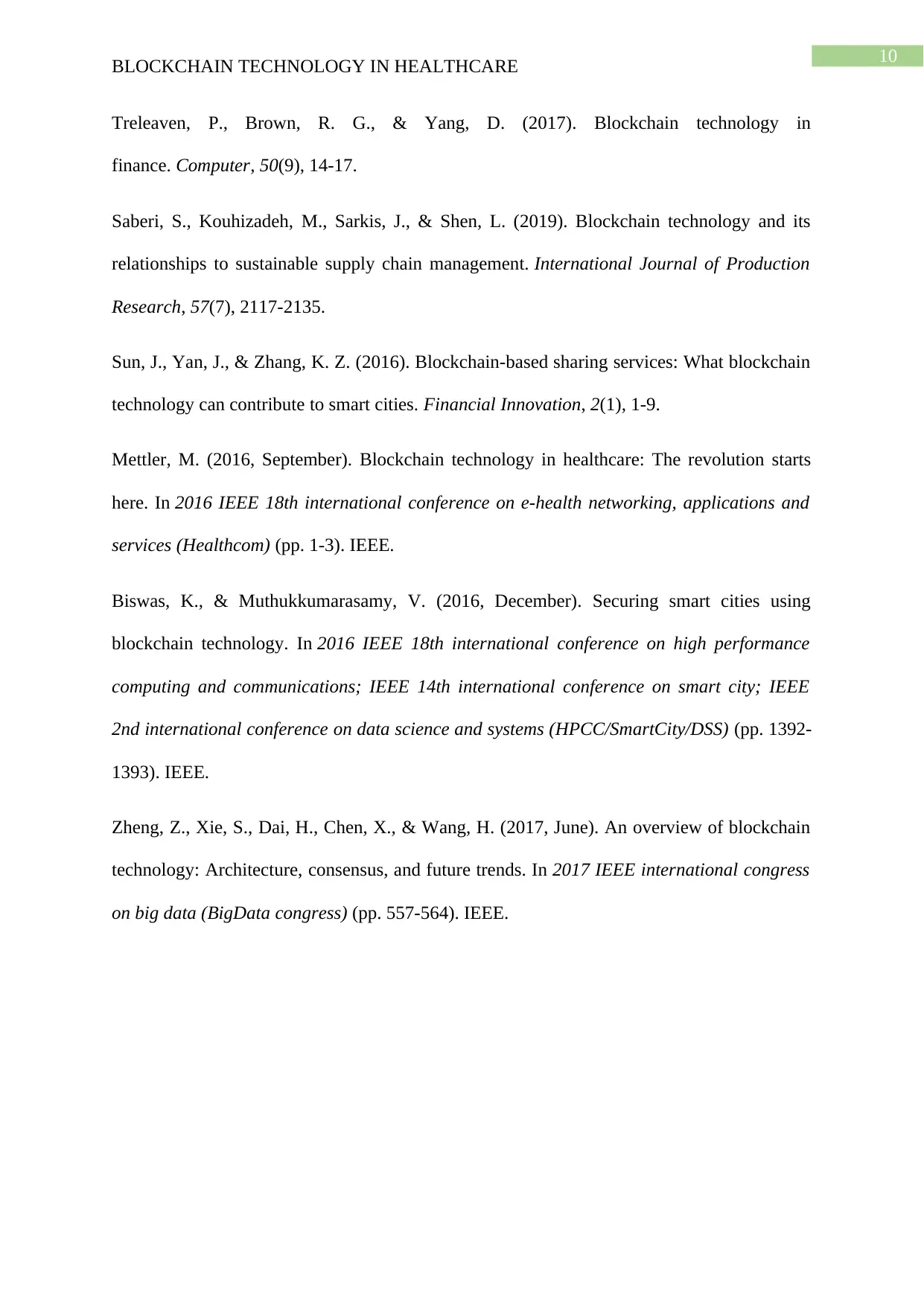
10
BLOCKCHAIN TECHNOLOGY IN HEALTHCARE
Treleaven, P., Brown, R. G., & Yang, D. (2017). Blockchain technology in
finance. Computer, 50(9), 14-17.
Saberi, S., Kouhizadeh, M., Sarkis, J., & Shen, L. (2019). Blockchain technology and its
relationships to sustainable supply chain management. International Journal of Production
Research, 57(7), 2117-2135.
Sun, J., Yan, J., & Zhang, K. Z. (2016). Blockchain-based sharing services: What blockchain
technology can contribute to smart cities. Financial Innovation, 2(1), 1-9.
Mettler, M. (2016, September). Blockchain technology in healthcare: The revolution starts
here. In 2016 IEEE 18th international conference on e-health networking, applications and
services (Healthcom) (pp. 1-3). IEEE.
Biswas, K., & Muthukkumarasamy, V. (2016, December). Securing smart cities using
blockchain technology. In 2016 IEEE 18th international conference on high performance
computing and communications; IEEE 14th international conference on smart city; IEEE
2nd international conference on data science and systems (HPCC/SmartCity/DSS) (pp. 1392-
1393). IEEE.
Zheng, Z., Xie, S., Dai, H., Chen, X., & Wang, H. (2017, June). An overview of blockchain
technology: Architecture, consensus, and future trends. In 2017 IEEE international congress
on big data (BigData congress) (pp. 557-564). IEEE.
BLOCKCHAIN TECHNOLOGY IN HEALTHCARE
Treleaven, P., Brown, R. G., & Yang, D. (2017). Blockchain technology in
finance. Computer, 50(9), 14-17.
Saberi, S., Kouhizadeh, M., Sarkis, J., & Shen, L. (2019). Blockchain technology and its
relationships to sustainable supply chain management. International Journal of Production
Research, 57(7), 2117-2135.
Sun, J., Yan, J., & Zhang, K. Z. (2016). Blockchain-based sharing services: What blockchain
technology can contribute to smart cities. Financial Innovation, 2(1), 1-9.
Mettler, M. (2016, September). Blockchain technology in healthcare: The revolution starts
here. In 2016 IEEE 18th international conference on e-health networking, applications and
services (Healthcom) (pp. 1-3). IEEE.
Biswas, K., & Muthukkumarasamy, V. (2016, December). Securing smart cities using
blockchain technology. In 2016 IEEE 18th international conference on high performance
computing and communications; IEEE 14th international conference on smart city; IEEE
2nd international conference on data science and systems (HPCC/SmartCity/DSS) (pp. 1392-
1393). IEEE.
Zheng, Z., Xie, S., Dai, H., Chen, X., & Wang, H. (2017, June). An overview of blockchain
technology: Architecture, consensus, and future trends. In 2017 IEEE international congress
on big data (BigData congress) (pp. 557-564). IEEE.
1 out of 11
Related Documents
Your All-in-One AI-Powered Toolkit for Academic Success.
+13062052269
info@desklib.com
Available 24*7 on WhatsApp / Email
![[object Object]](/_next/static/media/star-bottom.7253800d.svg)
Unlock your academic potential
Copyright © 2020–2025 A2Z Services. All Rights Reserved. Developed and managed by ZUCOL.





